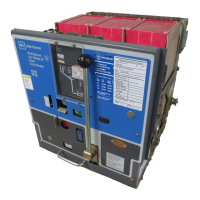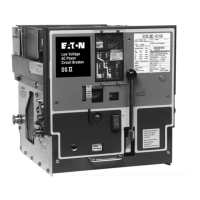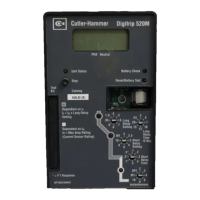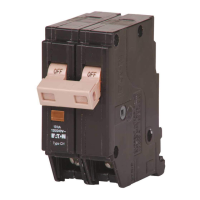Page 30
2.
In
the DISCONNECT position it prevents the breaker
from being withdrawn from its compartment.
3.
In
the TEST position it permits all normal no-load
operations
of
the breaker with the primary disconnect
contacts separated.
4.
In
the CONNECT position it prevents the disconnect-
ing
or
withdrawal
of
a closed breaker. This prevents
the drawing
of
dangerous, destructive arcs on the
disconnecting contacts if the circuit is loaded.
5.
While moving the breaker
in
either direction between
the TEST position and the CONNECT position
or
the
DISCONNECT position;
or
while standing
in
any
intermediate position, it prevents the closing
of
the
breaker. Therefore it prevents the connecting
of
the
closed breaker to the power circuits. This prevents
arcing on the disconnecting contacts as would occur
in
going into contact with a load on the circuit.
Here are the detailed interlocking conditions which exist
in
each
of
the four breaker positions:
5.1.
7.1
The REMOVE Position
This is the position
of
the breaker when nearest the front
of
its compartment, and is where the breaker must be
placed when it is installed after having been completely
outside
of
the compartment.
In
this position, the following conditions exist:
A.
The breaker is open.
B.
The closing springs are discharged. If
an
attempt is
made to charge the springs, a trip-free operation
will result.
C.
The breaker cannot be closed either electrically
or
by hand.
D.
The breaker can be withdrawn from the compart-
ment by direct pull. (The levering device is not
engaged with the cradle.)
E.
The levering device arms are
in
a horizontal posi-
tion with their rollers pointing toward the rear. See
Figure
6.
5.1.7.2 The DISCONNECT Position
In
this position the breaker has moved only a fraction
of
an inch into its compartment and will be shown by the
position indicator.
1.8. 33-790-11
In
this position the following conditions exist:
A.
The breaker will be held
in
its compartment as the
levering rollers have lowered into the slots
in
the
cradle arms.
B.
The shutter will close over the levering device hex
shaft.
C.
The shutter may be locked closed and the breaker
held trip-free by a padlock as described
in
Section
5.1.8.5, thus locking it
in
the compartment.
D.
Both primary and secondary disconnecting con-
tacts are separated.
E.
The breaker is open.
5.1. 7.3 The TEST Position
This is the position
of
the breaker when at a point
in
between the DISCONNECT position and the CONNECT
position, as shown by the draw-out position indicator.
In
this position the main disconnecting contacts are sepa-
rated enough to permit safe operation
of
the breaker.
However, the secondary contacts are made up.
In
this position the following conditions exist:
A.
The breaker must arrive
in
this position-from either
direction with its contacts open. Its closing springs
may be either charged
or
discharged when coming
from the connected position.
B.
When the levering crank handle is removed, it is
possible to close and trip the breaker by hand or
electrically.
C.
Just before the breaker arrives
in
the TEST posi-
tion from the DISCONNECT position, the second-
ary contacts make up and the spring-charge motor
automatically runs and charges the closing springs
on
power-operated breakers.
D.
The breaker can be closed by hand,
or
electrically,
after the springs are charged as
in
paragraph C
above.
E.
The breaker can be tripped open by hand, or elec-
trically through the shunt trip device.
F.
The trip plate on the hinged compartment door will
not trip the breaker.
G.
The breaker must be open before further levering
can be done.
H.
The overload tripping characteristics can be visu-
ally checked
or
changed. Amptector trip devices
can be electrically checked and calibrated with a
portable test kit. (Accessory equipment)
Effective October 1998
Courtesy of NationalSwitchgear.com

